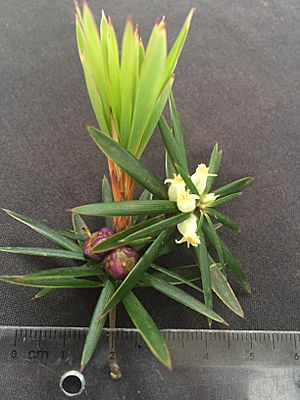Purple cheeseberry facts for kids
Quick facts for kids Purple cheeseberry |
|
|---|---|
 |
|
| Scientific classification | |
| Genus: |
Cyathodes
|
| Species: |
glauca
|
The Cyathodes glauca, also known as the purple cheeseberry, is a cool woody shrub or small tree. You can find it mostly in Tasmania, Australia. It belongs to the 'heath' plant family, called Ericaceae. 'Heath' plants often grow in open areas with lots of shrubs. They are tough and can live in well-drained, poor quality soils.
The name 'Cyathodes' comes from its flower. It looks like a tiny cup! 'Glauca' means bluish-grey or green. This refers to the lighter, often bluish color on the underside of its leaves. It's a special way to tell this plant apart!
Contents
What Does It Look Like?
Leaves
The leaves of the purple cheeseberry are dark green. They are long and pointed, usually about 2 to 4 centimeters (about 1-2 inches) long. They have lines running parallel, like stripes. The leaves often grow in groups, especially near the end of the stem. A cool fact is that the underside of the leaves is a distinct bluish-grey color. This is why it's called 'glauca'!
Flowers
This plant has many small flowers. They often grow at the very end of the branches. Sometimes, they grow alone where a leaf meets the stem. The flowers are tiny, about 1 centimeter (less than half an inch) big. They are white and shaped like a tube. Their petals curve backward, and you can see the parts that hold pollen sticking out. They also have a slight scent! You can see these flowers in spring and early summer.
Fruit
The fruit is very unique! It's a bright pink or purple berry. It's about 1 centimeter (less than half an inch) across. It looks a bit like a small, flattened tennis ball. This is where the name 'purple cheeseberry' comes from!
Where Does It Grow?
The purple cheeseberry is very common in Tasmania, Australia. It grows as a smaller plant under taller trees in open forests. You can find it below 1100 meters (about 3600 feet) in elevation. It is found almost only in Tasmania. There are a few rare spots in central-east New South Wales and far southwest South Australia. It likes to live in subalpine areas. These are places with tough, woody plants or wet forests.
How Does It Live?
The purple cheeseberry often grows with other common plants. These include Leptospermum scoparium, Pultenaea daphnoides, Monotoca glauca, and different types of Acacia trees. Cyathodes glauca likes soil that is moist but drains well. It also prefers soil that isn't very rich in nutrients. Because of this, you often find it on rocky slopes and in areas with many boulders. These places usually have clay soils over a type of rock called dolerite. The slopes it likes often face southeast. They are usually gentle to medium in steepness and have good drainage.
Plant Family Connections
There are three other known species in the same plant group as Cyathodes glauca. This group is called Cyathodes. One of them, Cyathodes platystoma, is a threatened species. It has the largest leaves and only grows in wet forests on the Tasman Peninsula. Another species, Cyathodes straminea, looks very similar to C. glauca. However, it has smaller leaves and dark red berries. It is only found above 1100 meters (about 3600 feet) in elevation.
Other well-known plants in the same family, Ericaceae, include yummy blueberries and cranberries. Rhododendrons, with their beautiful flowers, are also part of this family!

